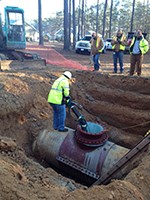 Cobb County-Marietta Water Authority (CCMWA) is the second largest drinking water supplier in Georgia, providing vital service to nearly 800,000 people through twelve wholesale customers. With two award-winning water treatment plants and over 200 miles of large-diameter transmission mains, CCMWA can deliver up to 158 million gallons per day. Two of CCMWA’s key objectives are to be financially viable and to reduce vulnerabilities by improving redundancy and implementing a comprehensive asset management program.
Cobb County-Marietta Water Authority (CCMWA) is the second largest drinking water supplier in Georgia, providing vital service to nearly 800,000 people through twelve wholesale customers. With two award-winning water treatment plants and over 200 miles of large-diameter transmission mains, CCMWA can deliver up to 158 million gallons per day. Two of CCMWA’s key objectives are to be financially viable and to reduce vulnerabilities by improving redundancy and implementing a comprehensive asset management program.
However, across the United States critical infrastructure is aging, causing utilities to see an increased number of water pipe failures. While these failures occur most commonly on small pipes – causing only minor disruptions – large-diameter mains do fail, resulting in major delays and enormous repair bills.
A large portion of CCMWA’s large-diameter pipeline inventory is made up of Prestressed Concrete Cylinder Pipe (PCCP). In order to successfully manage PCCP, the water industry has widely adopted the use of condition assessment techniques, which have a proven track record of identifying and averting PCCP failures. PCCP owners and operators continue to use these condition assessment methodologies combined with sound engineering analysis to effectively and safely manage their critical assets.
Cobb County’s Program
In 2012, CCMWA was in a similar situation to many predominant PCCP users; past failures on these critical assets had led to the decision to replace the majority of PCCP assets to avoid the risk of future failures. However, it was determined that replacing large sections of pipeline was not financially or logistically feasible.
Large-scale replacement programs are also unnecessary based on industry research, which confirms that pipe deterioration is not uniform or systematic. Specifically, electromagnetic inspection data (which identifies both the quantity and location of broken prestressing wires – the primary structural component of PCCP) collected by Pure Technologies over more than a decade indicates that less than 4 percent of pipe sections inspected have any level of wire break damage and less than 1 percent require repair – regardless of when it was manufactured.
